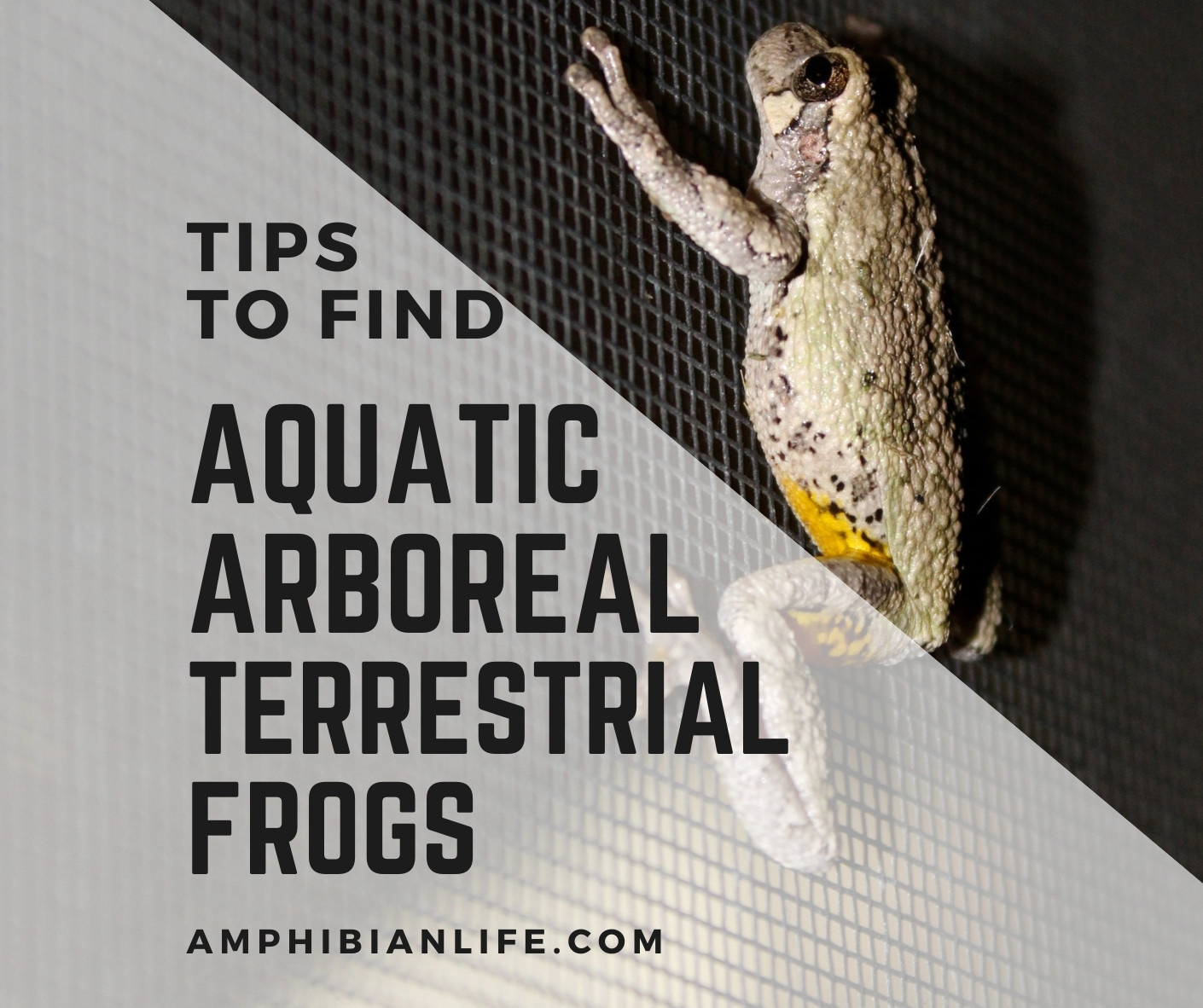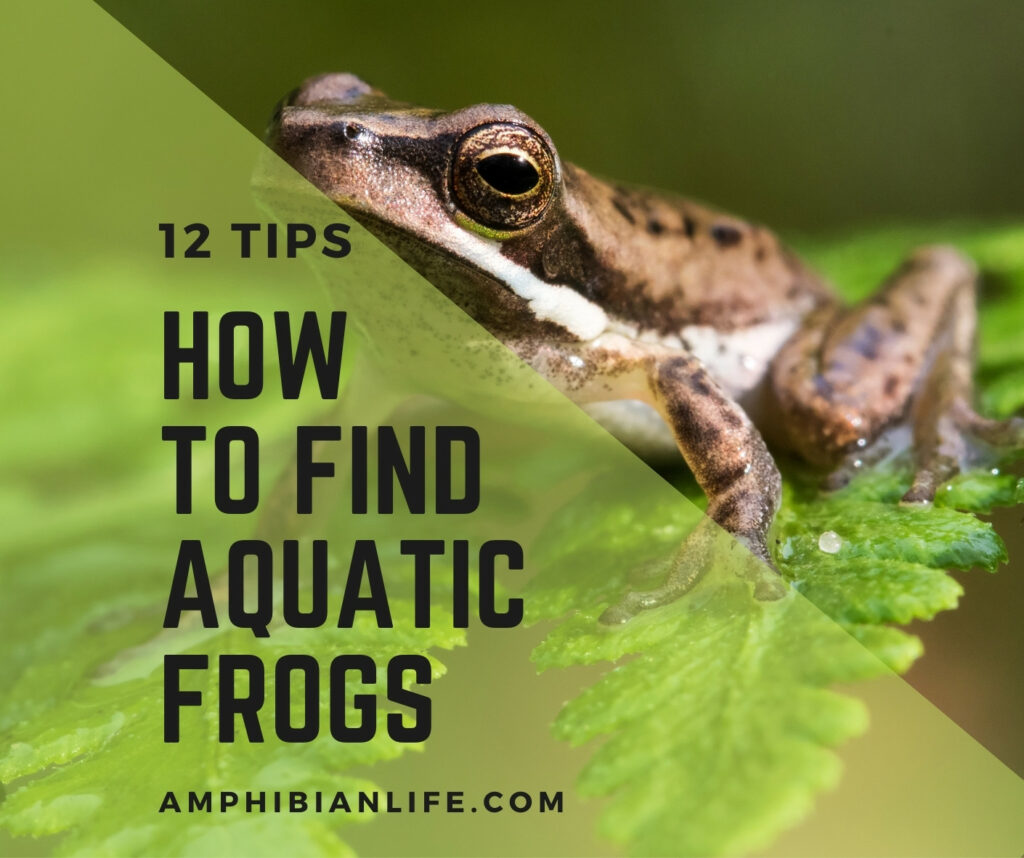
How and Where to find Aquatic frogs?
Finding a frog is a fun task, especially because they are glossy and keeps jumping around. More than adults, kids find it fascinating whenever they spot a frog.
Frogs are present everywhere, from woods to your backyard or the front garden. But if you are looking specifically for Aquatic Frogs, you have to search in the nearby water bodies.
Once you step into nature, especially with water bodies around, you can continuously hear frogs croaking.
Or if not that, these little amphibians can be found jumping from one creek to another pond and so on.
Finding and catching the aquatic frogs can prove quite enjoyable. And for doing the same, these 12 useful tips will surely help you. Have a look over them:
Types of Frogs based on Habitat
There are basically 3 types of Frogs
- Aquatic Frogs ( They mostly live in water Such as African Dwarf Frogs)
- Arboreal Frogs ( They live on tress Such as Waxy Monkey Tree Frog)
- Terrestial Frogs/ Toads ( They live on land such and Surinam or Cane Toad)
12 Easy ways for Finding aquatic frogs in wild
As you know, Aquatic frogs are found in water bodies; you’ll have to first step out of your residential comfort zone.
For the process, you can visit a nearby park, forest, or other such properties that have lakes, ponds, creeks, etc.

Tip # 1 Find Aquatic frogs on the banks of shallow ponds.
It is ideal to step out during the daytime with enough natural light. Look at the edges of water (pond) or over decaying vegetation, algae, and other vegetation. You may find frogs either sitting atop some vegetation or submerged halfway into the pond’s water. Try locating their head. Although finding a green frog is a task with all the algae and decayed vegetation is still possible.
Tip # 2 Find Aquatic frogs on a Fen or Bog Pool.
If you know about a freshwater wetland, it possibly has some frogs’ houses. Especially if it is a fen or bog pool, the aquatic frog population can rightly be there. You can find frogs sitting over grassland there or poking their little head over the water level.
Tip # 3 Avoid Saltwater and brackish water wetlands.
Aquatic frogs might not survive well in brackish water. Saltwater can damage frogs’ respiratory and hydration systems, making it difficult for aquatic frogs to survive. Thus, avoid places like oceans, lagoons, bays, channels, salt marshes, etc. However, some Crab-eating frogs can tolerate the condition and live happily.
Tip # 4 Find frogs on the lakeshore.
Lake shoreline is often full of aquatic frogs, though the right timing plays a crucial role in finding them. Either look for them before sunrise or after sunset, when the place is less populated by humans.
Tip # 5 Do not look for aquatic frogs in full sun.
It is because aquatic frogs do not love the sun, and thus, during the daytime, they prefer staying inside water under vegetation shade. Ideally, during the peak sunny hours (From 12 pm through 4 pm), frogs will not even come to the water surface. Thus, avoid peak sunny hours or small ponds with no vegetation shade as you might not find any frog.
Tip # 6 Find frogs in slow-moving water.
If the lakeshore welcomes frequent waves and a lot of movement, chances are you may not spot a frog there. Also, if the water is too deep (middle of the lake), frogs will refrain from going there. It is always the slow-moving water that interests and comfort aquatic frogs.
Tip # 7 Find aquatic frogs in or around an icy mountain stream.
Aquatic frogs love cold water, and thus spotting them in a mountain stream is common. For example, the Titicaca Water Frog loves relaxing in water that is 46.5 to 63.5 degrees Fahrenheit. Water frogs can even survive in or under 40-degree Fahrenheit, though not all of them.
Tip # 8 Find aquatic frogs in Creeks and Brooks.
Slow creeks and brooks are other suitable places to spot water frogs. And if the creek has some plantation or vegetation, the chances of spotting a frog are quite high.
Tip # 9 Avoid looking for aquatic frogs in fast-flowing creeks or rivers.
Frogs love living in highly vegetated and slow pacing water bodies. Thus, if it is a river or a fast-flowing creek nearby, chances are you will never find a frog there. It is because high waves and water currents can dislodge eggs or wash off their tadpoles. Hence to survive, frogs avoid habituating in such areas.
Tip # 10 Find aquatic frogs in swamp, marsh, and Bayou.
Wetlands like swamp, marsh, and Bayou are home to freshwater along with abundant live or decaying vegetation. And all these conditions make a suitable habitat for aquatic frogs. However, with an overflow of vegetation, locating a frog can become tricky.
Tip # 11 Aquatic frogs cannot survive in chemically polluted water.
Avoid finding aquatic frogs in polluted water, especially if the water body is chemically polluted. Like Saltwater, chemical pollution too can hinder frog’s ability to breathe to stay hydrated. Avoid places like sewage, sewer, or wastewater pool.
Tip # 12 Look for the aquatic frogs on the water surface or over vegetation in wintertime.
Frogs hibernate during winters; thus, aquatic frogs spend winters sticking to the grounds of ponds or other water bodies.
While finding an aquatic frog, be patient and go slowly. If you make noise or pace quickly, frogs will get scared and hide somewhere.
However, if the water scenario (vegetation and algae) makes it difficult for you to spot frogs, then- Lightly throw a small stick or stone on the clear side of the water.
It might make frogs appear over the surface, and you can easily spot them. Though at any cost, refrain from hurting frogs.
Tips for Finding Arboreal Frogs
Arboreal Frogs are the ones who spend their entire life or a major portion living on trees.
However, like aquatic frogs, they too require a steady water source to soak and survive.
Long stretches without water can end up tree frogs with nasty infections or skin diseases.
Here are some quick tips for finding Arboreal or tree frogs:
- The easiest place to find Arboreal frogs is a tree. However, the process can become frustrating because tree frogs camouflage well with leaves, bark, and other tree parts. Thus. Observe the tree nicely until you find a shiny bump.
- Look for arboreal frogs under fallen leaves, especially dead and dry leaves. Tree frogs find it comfortable and cool hiding under leaves litter. It also hides them from predators.
- If you live in South America, you can find tree frogs sticking with leaves. Frogs find leaves comforting. Thus they feel free relaxing there.
- Look for tree frogs near a water source. Even though tree frogs do not leave constantly underwater like the aquatics, they still prefer living on trees near water. It helps them in keeping hydrated. Thus if there’s a pond, creek, or marsh with trees nearby, chances are you can spot several frogs.
Tips for finding Terrestrial Frogs
Terrestrial Frogs are the ones who live in both land and water. While most of the time, they hide underground or beneath rocks for mating and reproduction, they will return to the water.
Here are some tips for finding terrestrial frogs:
- As said above, Terrestrial frogs love living under rocks or underground. You can also find the under piles of leaves, branches or even in a mud puddle.
- Terrestrial frogs also love hiding at places where they can stay cool. You can locate them near vegetation, water bodies, or even grasslands. They also love living in humid lands.
- Terrestrial frogs live freely during the night hour. It is the right time when you can spot them jumping, running and actively eating bugs. Look at the base of trees or on humid grass.
- You can also spot terrestrial frogs near a light source. It is where they find multiple bugs and wherever there are bugs, frogs will surely reach.
Frequently asked questions
Springs and summers are notedly the best time to find frogs. They are also highly active during the monsoon or rainy season. It is when you can often hear the croaking sound also their mating noise.
Shady lakes, ponds, and streams likely houses frogs. Your nearby state park, national park, or forested region will have water bodies housing frogs.
For catching a frog, it is best if you can visit a small pond or marsh. Take a net along with you or a bucket that has holes underneath.
Once you locate frogs, try catching them slowly but smartly. Remember, frogs are extremely quick that you might miss several chances.
Catching a frog that has sneakily entered your house can become a painful task. You cannot simply run after it, or else the process will go on for hours.
Instead, simply lay down a few wet towels on the floor and monitor them frequently. The lost frog will most likely come over them for retaining moisture.
Wrapping up
This was about our experiences and research about finding an aquatic frog.
You can trustfully go with the tips given above and find yourself a water frog on your next forest trip. Or, if it is a tree frog, you might find it in your backyard.
For them, keep a big bowl full of fresh water so that the tree frog can keep moist whenever required.
